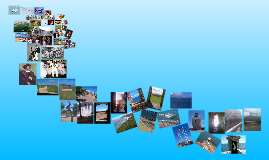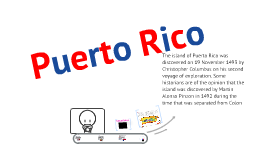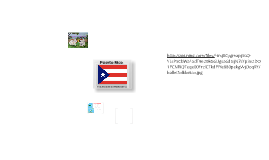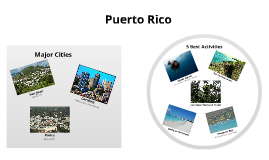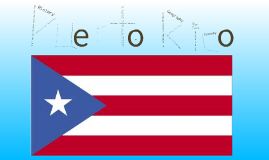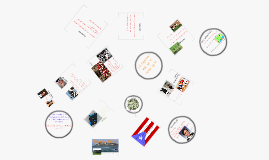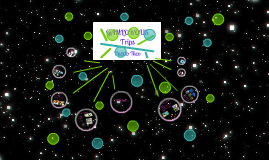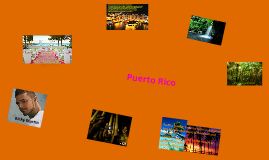Puerto Rico
Transcript: Puerto Rico Land and Climate Same Size as Rhode Island and Delaware combined The island of Puerto Rico is characterized by the Cordillera Central (a high central mountain range), a dry southern coast, fertile northern coastal plains, low eastern mountains, and El Yunque rain forest. History Taino people were living in Puerto Rico when Columbus arrived in 1493 and named the island San Juan Bautista. The Spanish introduced slavery and diseases that decimated the indigenous population. Slavery was not abolished until 1873. In 1897, Spain granted Puerto Rico self-ruler under the leadership of Luis Munoz Rivera. In 1898, as part of the Spanish-American War, the United States invaded the island and conquered its Spanish defenders. In 1946, President Harry S. Truman appointed Jesus Toribio Pinero as the first island-born governor. Two years later, Puerto Ricans directly elected a governor, Luis Munoz Marin. The People In 2010 census, the population of Puerto Rico was 3,725,789 people. There is no record of the population since then. More than 95% of the people are native Puerto Rican, with a mixed Spanish, African, and Taino heritage. Language In the early 1990's, Spanish was declared the only official language, but English has since regained equal status. Most people can speak English. They are comfortable speaking Spanglish. Slang Words Broki-Buddy Galan-Dude Bambalan-Lazy Bum Chavos-Money Chévere-Cool Diantre!-Wow Lo Siento-I'm sorry Religion Roman Catholicism is the major Christian Religion and claims about 85% of the population as members. 15% of the people belong to various Protestant and other Christian churches, and their members growing. Consider themselves to be religious and often attribute their good fortunes to Deity. Personal Appearance Puerto Ricans takes great pride in what they wear in public. youth favor popular Noth American fashions and also lilke a sporty look Sloppy, overly casual, or revealing dress is considered inappropriate Greetings People usually shake hands when greeting. Close friends often greet by grasping shoulders and kissing each other on the cheek. Women normally kiss women or men in this manner, but men do not greet other men this way. They may embrace a good friend or relative after a long absence. People stand very close when talking, and females often touch each other with their hands. Moving away, even slightly, may be considered an insult. Gestures To point, people often purse or pucker their lips in the direction indicated. A person can get another's attention by saying "pssst." This is common and not rude, but if a man does it to a woman, she will likely ignore him. One beckons by waving all fingers with the palm down; beckoning people with the palm facing up is improper. Wiggling the nose can mean "What's going on?" Men often smile and stare at women, but it is considered improper for a women to smile indiscriminately at strangers. Visiting Most casual visits occur in the evening without prior arrangement. Visits are relaxed and the entire family participates. Puerto Ricans' favorite sport is baseball, but people also enjoy basketball and volleyball. Families enjoy going to the beach or parks for picnics. Card and board games are popular. Government Famous Puerto Ricans Roberto Clemente Head of State Barack Obama Dating and Marriage Youth begin dating in groups. Having a boyfriend in important Dating doesn't serious until the boy meets the girls parents. Puerto Ricans marry at ages 19-21. They have great celebrations for weddings. Carlos Beltrán Head of Government Luis Fortuno Recreation Puerto Ricans' favorite sport is baseball, but people also enjoy basketball and volleyball. Families enjoy going to the beach or parks for picnics. Card and board games are popular. Ricky Martin El Yunque rain forest They are gregarious and fond of fiestas (celebrations) They admire people who are intelligent, hardworking, dedicated, and humble. Puerto Ricans consider open criticism, aggressiveness, and greed offensive. Gaining a good education is considered a key to a better future. Being able to buy land for a home or business is a universal goal. People are considered more important than schedules.






